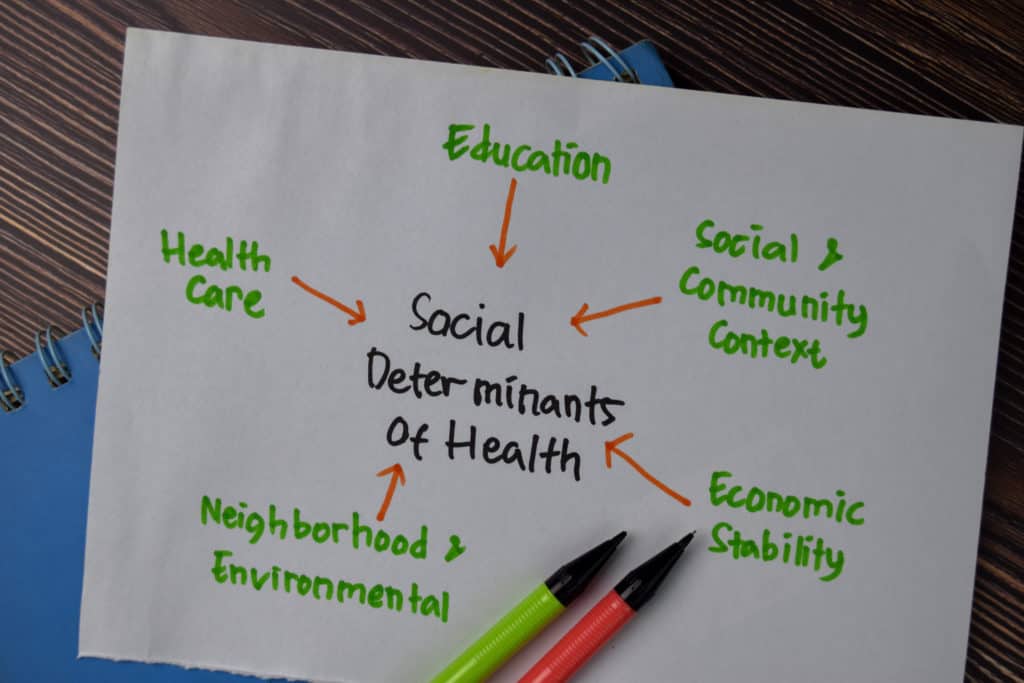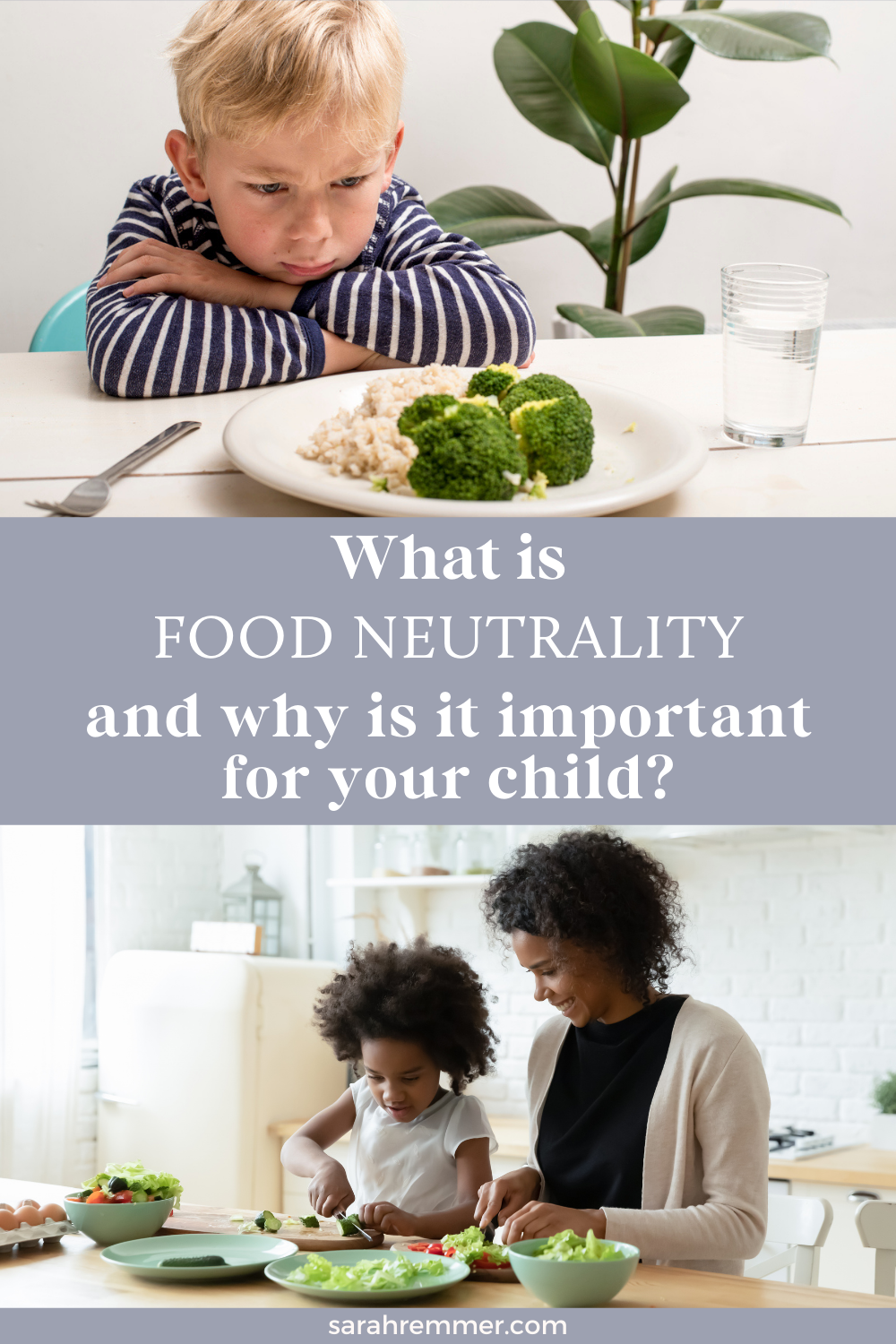What is Food Neutrality, and Why is it Important for your Child?
[ad_1]
If you want to raise children who have a positive relationship with food and body, creating food neutrality at home is important. Here’s how to do it.

Sometimes us parents over-complicate things when it comes to teaching our kids about nutrition, when really all that we want is for them to learn to love a variety of foods and have a positive relationship with food long term. Food neutrality is a term that you may not be familiar with, but it’s one that you’ll want to explore and familiarize yourself with if you’re wanting to raise intuitive eaters. Here’s what’s in this post:
The issue is “diet culture”
As a generation who grew up with a mentality about health that was deeply rooted in diet culture–one that suggested or taught us that our weight and size determined our health status– it’s important to be mindful of how we’re unintentionally passing this along to our little ones.
We know now that health has so many determinants: activity levels, mental well-being, sleeping habits, genetics, environment, access to food, nutritional habits, stress level etc. Notice that weight and size are NOT included. We also know that fixation on weight, the number on the scale, restriction of certain foods, limiting portion sizes etc. does not lead to improved health and can actually create disordered eating patterns and poor body image.

Why Food Neutrality?
Ultimately, we want our kids to:
- Be calm around treats and sweets.
- Feel confident in their eating abilities.
- Grow into the body that is right for them.
- Learn to love a variety of foods on their own.
- Listen to their bodies when it comes to amounts and learn how to self-regulate.
- Not feel shame or guilt for eating certain foods.
- Not attach their eating or weight to their worth.
- Know that food is valuable in many ways.
In order to achieve this, we need to:
- Talk about our body positively and focus on what our body CAN do.
- Not label foods as good/bad, green light/red light, healthy/junk. Just call them by their names: spinach, ice cream, chicken, cookies etc.
- Try our best not to micromanage our child’s food intake at meals/snacks. That’s up to them.
- Encourage our child to eat until their tummy is done eating (and close the kitchen after).
- Encourage fun movement everyday.
- Offer treat foods regularly without shaming kids for eating them.
You might be asking “Ok, this is what I want, but where do I start?!”. If this is you, keep reading!

What is food neutrality?
One of the things that diet culture has taught us is to place foods on a hierarchy and attach moral value to them. So, “healthy” foods (those that are unprocessed and nutrient-rich) are “good”, and foods that lack nutrition or are ultra-processed are “bad”.
Now, there’s no denying that broccoli has more nutrition than jellybeans, or that unprocessed chicken breasts are more nutrient-dense than deep fried chicken wings. We all know this. But as soon as we start villainizing those less nutritious foods and pressuring our kids to eat those “good” foods (fruits, veggies etc.) we create a situation where kids feel guilty, naughty or “bad” for eating, or even WANTING to eat those foods. It can create a situation where kids are internally labeling themselves as “good” or “bad” based for what they’re eating.
Children think in very concrete terms (they aren’t yet able to think abstractly) so those food labels can easily become self-labels. Kids can start to feel guilty and ashamed for wanting to eat these foods, and picky eating power struggles can often be perpetuated. What happens next? Well, long-term it can lead to food sneaking or hoarding, emotional eating and disordered eating. Not at all what we want for our kids.
Food neutrality is not saying that all foods have the same nutrition. Food neutrality essentially means that we as parents are removing the moral value. That means dropping labels like “good”, “bad”, “healthy”, “unhealthy”, “junk”, “red light”, “green light” or even “sometimes food”, and just calling foods by their name: “carrots”, “jelly beans”, “cupcake”, “chicken” etc.
It means putting foods on a level playing field. It’s just food. Some foods give us quick energy, taste sweet and remind us of grandma’s house (cookies), and other foods help our eyes to see better and keep us from getting sick. Both valuable!

Health is multifaceted – it’s not determined by body weight, size or shape
It’s important to keep in mind here that health is multifaceted and it doesn’t just mean “eat healthy and exercise”. Yes part of health is making sure that you’re consuming nutrient-dense foods and moving your body, but it also means connection with others, good sleep habits, prioritizing mental health etc. and it’s important that we convey this to our kids too. Weight is NOT an independent risk factor for disease or poor health. We know this.
The BMI (Body Mass Index), which is the cornerstone of our very weight-centric medical system, is based on bad science and is extremely nuanced. Yet, many doctors continue to use it as the number one determinant of health. It’s not. Health is determined by so many factors, lifestyle behaviours being the big one. NOT body weight, size or shape. This is really important to know and will give so much context into why food neutrality is so important.

What food neutrality is NOT:
What food neutrality does NOT mean is dismissing nutrition all together and only serving treats all day. Nutrition is not lost here – after all, I AM a pediatric registered dietitian. Proper nutrition is crucial to a child’s ability to grow, develop and thrive. But WE are the feeders. WE are in charge of what is served, when it is served and where it is served.
Our children decide if and how much they eat. It is our job to serve a variety of nutritious foods several times a day. So, our children will have plenty of opportunities to enjoy and explore these foods, without you having to shove the healthy lingo down their throats (so to speak).
As parents, we know that these foods are nutritious and important for growth and development. That doesn’t mean that we have to tell our kids that they are “good” or “healthy”. In fact, labeling them as such might just translate in their brains as “yucky” (cue picky eating). All that we have to do is normalize them: serve them, call them by their name, eat them and create a positive eating environment. Let them do the rest!
How to change the “food narrative”
The question is, can you change the narrative and teach your kids about foods, rather than teaching them about nutrition? Can you talk about all foods and the different values that each bring? By being matter-of-fact, positive, and calm, this will help your child to follow suit.
Here are some practical examples that demonstrate food neutrality:

Carbohydrates
“We eat lots of different foods every day, for different reasons. Some foods, like oatmeal, apples and homemade muffins help our bodies to have long-lasting energy so that we can run and play.”
Protein
“Other foods, like eggs, beans and chicken help to make that energy last longer! These foods also help to build our muscles in our arms and legs so that we can climb the monkey bars or jump really high.”
Fat
“Foods like avocado and peanut butter help to keep our hearts pumping properly. They also can be stored in our body as extra energy and fuel in case we need it!”
Vitamins
“Orange foods like mandarin oranges, carrots and squash help our eyes see better! And red foods like tomatoes and beets help to keep our brains sharp, and help to keep us from getting sick.”
Minerals
“Milk, chia seeds and yogurt help to build strong bones and teeth! This makes our bodies stronger, and helps us to do all of the fun things that we want to do like skate, play soccer and eat crunchy, yummy foods!”
How to talk about individual foods
These are just a few examples. You can also explain the value of individual foods (rather than nutrients i.e. carbohydrates, protein, fat, vitamins, minerals). Here are some examples:
Carrots
“Carrots grow in the ground. When they’re ready to eat, they’re crunchy and a bit sweet! The orange colour in carrots helps our eyes to see better. We can either eat them raw with a dip or we can cook them to make them soft. “
Barley
“Barley gives us our body long-lasting energy so that we can play for a long time and gives or brain energy to learn in school. Barley sometimes goes into soups or we can eat it by itself. It’s white and fluffy, kind of like rice but a bit bigger!”
Cabbage
“Cabbage can be bright purple or green. Foods like cabbage with bright colours can help to keep us from getting sick. Cabbage has big leaves that we can eat either hot (cooked) or cold (raw)”.

What about sweet foods and processed foods?
Sweet foods
“Cookies give us really quick energy, which means that it doesn’t last very long. They taste really yummy and might remind us of Grandmas house! We love making cookies together.”
Processed snacks
“Potato chips are crunchy and salty. They don’t really help our bodies to stay energized or strong, but they’re fun to eat because they taste good and make a loud crunch! We sometimes eat potato chips when we have family BBQs.”
What to do if the people around you don’t practice food neutrality?
Once you’ve embraced and practiced food neutrality, you’ll start to really notice the comments and behaviours of other people who aren’t aware of food neutrality or don’t understand it. You know… aunt Carol who comes for Easter dinner and makes unsolicited comments about your child’s eating (or lack of eating), the amount that they’re eating, or the pace at which their eating? As well-meaning as it is, it can be confusing for a child to hear, and frustrating for you as the parent. It’s important to know how to set boundaries and lessen the confusion, but it can be tricky to know what to say in those instances. Here are some examples:
Food pressure

Aunt Carol: “Jonny, make sure to eat your dinner! It’s Christmas!”
“Oh thanks for your concern aunt Carol, but we’re letting Jonny eat what he’d like (and as much he’d like). He knows the kitchen will be closed after this, and how much his body needs”.
Aunt Carol: “Make sure you have 3 more bites – dessert is coming!”
“Oh thanks, but we don’t require her to eat a certain amount of food before dessert. She’ll be offered dessert no matter what.”
Aunt Carol: “Really?? She’s allowed to have more bread without even trying her turkey? That’s just pure carbs! “
“Yep! We let her decide which foods (and how much) she wants to eat. It’s all just food! We trust that she knows her body best.”.
Picky eating labels
Aunt Carol: “Oh don’t be so picky! Have a bite for aunt Carol”
“Actually, he’s not picky, he’s just still learning. We don’t pressure him to eat anything that he’s not ready to eat on his own. Thanks for your concern though. “
Inadvertent body shaming
Aunt Carol: “You won’t get big and strong unless you eat your turkey”
“What aunt Carol meant to say is ‘foods like turkey help to build muscles in your body. But there are lots of other foods that you eat that help with that too! Your body is perfect just the way it is’.”
Inadvertent food shaming
“You can’t just eat cookies – it’s pure sugar. It’s not good for you!”
“Oh, actually we’re offering her cookies regardless of how much she ate at dinner–no strings attached! These foods are a big part of the joy of the holidays and we don’t want her to miss out on that.”
It’s not going to be perfect – you will slip up and that’s ok
No one is expecting perfection. You’re only human! And you’ve also lived and grown up in an era where diet culture was (and still is) pervasive. These diet-culture ridden ideas, narratives and messages are deeply ingrained and it takes time and patience to “unlearn” them. Give yourself some grace and just practice awareness. Self-reflect, notice and ask yourself where your words are stemming from, what your fears are and which nutrition “rule book” you’re following. Challenge your deep-rooted beliefs and keep an open mind. Your children will thank you!

[ad_2]
Source link




